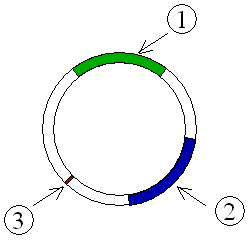
While very promising, optical mapping may not yet be suitable for the detection of shorter (<50 kbp) plasmids ( Nyberg et al., 2016). With the help of fluorescent dyes, a unique barcode roughly depicting the DNA sequence of a plasmid can be made and compared to barcodes in a reference database. In recent years, optical DNA mapping of plasmids has been developed, based on the visualization of the plasmid DNA stretched in nanofluidic channels. Moreover, neither of these methods yields much information about the plasmid DNA sequence. Pulsed field gel electrophoresis reveals the size and number of plasmids in an isolate, but the process can take several days ( Nyberg et al., 2016). While quick and cheap, multiplex PCR is hard to extend to cover all novel plasmid groups ( Carattoli et al., 2014).

PCR-based replicon typing targets the conserved replicon sites of plasmids ( Smalla, Top & Jechalke, 2015) and it can be expanded to target many replicons by using multiplex PCR ( Carattoli et al., 2014). There are several methods for plasmid detection, all with their own merits and drawbacks. Thus, considerable effort has been put into plasmid detection and monitoring. Bacterial plasmids often confer beneficial traits to their hosts, such as antimicrobial resistance, which has directly contributed to the rapid increase of multidrug-resistant bacteria, described as one of the greatest dangers to human health ( Nyberg et al., 2016). They have been described in all three domains of life ( Antipov et al., 2016). I design primers to either or both depending on the project.Plasmids are circular or linear double-stranded DNA molecules capable of autonomous replication and conjugation. Turning on the Matching Bases/Residues as Dashes quickly shows regions of homology and divergence.

Showing regions of homology at the protein level and then having the colinear DNA sequence presented in the same view (Summary window) helps find regions suitable for primer design. Most recently, I've been using it to make comparisons of genes retrieved from the databases for cross-species cDNA cloning. This is done by alignment in Sequencher and then formatting the Summary view to display the resulting changes in protein translation.For my own projects, I use Sequencher as a very general multiple-alignment sequence editor. Rapid assembly and editing of total plasmid sequence and then comparison to the reference file on record is all done in Sequencher.The third most popular request is: compare this library of (protein improvement) mutants and tell me which ones have protein changes. Alignment of ABI data files against a 'reference' sequence (template file) quickly eliminates defectives by showing not only base changes but the consequences to the protein translation.The second most popular request is: validate this new maxiprep so it can be given to. The most popular request I receive in the DNA core lab is: find the good clone among this group of 'candidate' minipreps. Using this feature I am not only able to export whole table but also selected few columns using “export selected” option button. With this feature it is now possible to export genotypes. Technical Support group at the Gene Codes Corporation has been very receptive to the idea of introducing variance table.


sample ID, primer ID, or well position etc. Assemble to reference by defining assembly parameters using advance expression feature is very useful, it saves a lot of time and sequences can be assembled by defining feature of your choice e.g. What I liked in this new version is assembly function & variance table. It was a pleasure to be involved in the beta test program for version 4.6. I have been using it for sequence analysis of ABI data files since 2000. Sequencher was of tremendous help to me in these projects for- discovery of SNPs, detection of known SNPs, intronic/exonic SNPs & amino acid changing SNPs. I am involved in resequencing projects for disease association studies.


 0 kommentar(er)
0 kommentar(er)
